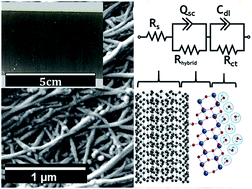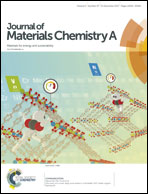Large area photoelectrodes based on hybrids of CNT fibres and ALD-grown TiO2†
Abstract
Hybridisation is a powerful strategy towards the synthesis of next generation multifunctional materials for environmental and sustainable energy applications. Here, we report a new inorganic/nanocarbon hybrid material prepared by atomically controlled deposition of a monocrystalline TiO2 layer that conformally coats a macroscopic carbon nanotube (CNT) fiber. Through X-ray diffraction, Raman spectroscopy and photoemission spectroscopy we detect the formation of a covalent Ti–O–C bond at the TiO2/CNT interface and a residual strain of approximately 0.7–2%, which is tensile in TiO2 and compressive in the CNT. It arises after deposition of the amorphous oxide onto the CNT surface previously functionalized by the oxygen plasma used in ALD. These features are observed in samples of different TiO2 thicknesses, in the range from 10 to 80 nm. Ultraviolet photoemission spectroscopy on a 20 nm-thick TiO2 coated sample gives a work function of 4.27 eV, between that of TiO2 (4.23 eV) and the CNT fiber (4.41 eV), and the presence of new interband gap states that shift the valence band maximum to 1.05 eV below the Fermi level. Photoelectrochemical measurements demonstrate electron transfer from TiO2 to the CNT fiber network under UV irradiation. Electrochemical impedance spectroscopy measurements reveal a low resistance for charge transfer and transport, as well as a large capacitance. Our results point to the fact that these hybrids, in which each phase has nanometric thickness and the “current collector” is integrated into the material, are very different from conventional electrodes and can provide a number of superior properties.



 Please wait while we load your content...
Please wait while we load your content...